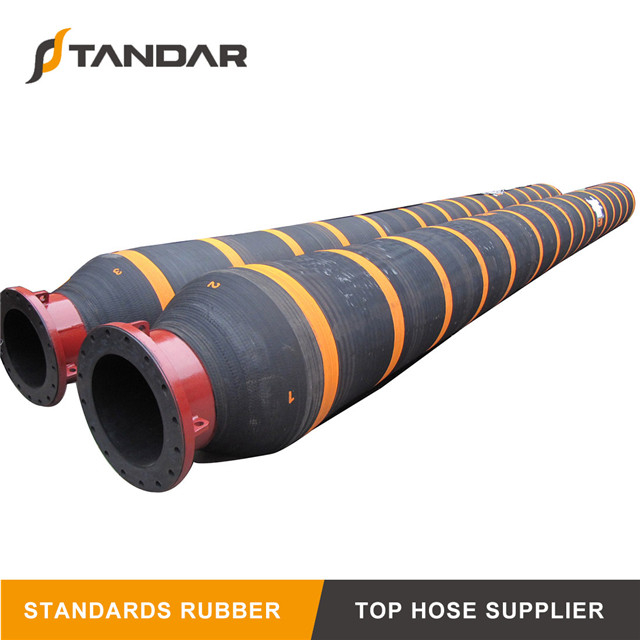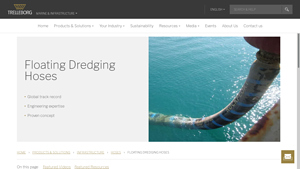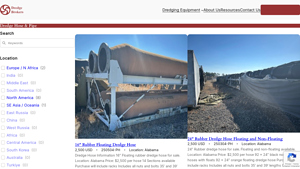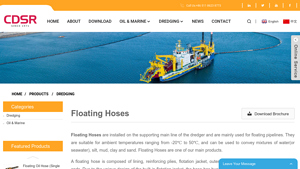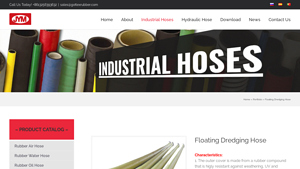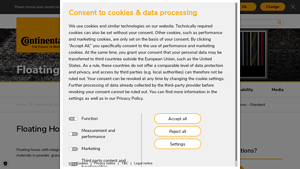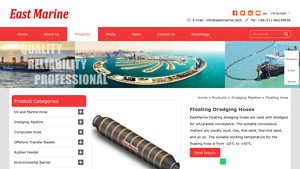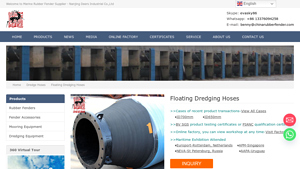Introducción: Navegando por el mercado mundial de mangueras de caucho flotantes
En el mercado global actual, el abastecimiento de mangueras de caucho flotantes de alta calidad presenta un conjunto único de desafíos para los compradores B2B, en particular los que operan en regiones como África, Sudamérica, Oriente Medio y Europa. La demanda de mangueras de caucho flotantes está impulsada por sus aplicaciones críticas en el dragado, el transporte marítimo y la gestión medioambiental. Sin embargo, navegar por las opciones de los proveedores, las distintas especificaciones de los productos y los costes fluctuantes puede resultar desalentador. Esta guía está diseñada para ayudar a los compradores internacionales proporcionándoles un análisis exhaustivo de las mangueras de caucho flotantes, incluidos sus tipos, aplicaciones y consideraciones esenciales para la investigación de proveedores.
A lo largo de esta guía, profundizamos en los distintos tipos de mangueras de caucho flotantes disponibles, explorando sus aplicaciones específicas en diversas industrias. También abordamos los factores clave que influyen en las decisiones de compra, como la durabilidad, la flotabilidad y la resistencia a los factores ambientales. Además, ofrecemos ideas sobre cómo evaluar eficazmente a los posibles proveedores, garantizando la elección de socios que cumplan rigurosas normas de calidad y puedan cumplir los plazos de entrega.
Al proporcionarle información práctica y conocimientos estratégicos, esta guía facilita la toma de decisiones de compra informadas que se ajustan a sus necesidades operativas y a sus limitaciones presupuestarias. Tanto si tiene su sede en Brasil como en Nigeria, comprender la dinámica del mercado mundial en torno a las mangueras de caucho flotantes es esencial para optimizar su estrategia de compras y mejorar la ventaja competitiva de su empresa.
Índice
- Lista de los 7 mejores fabricantes y proveedores de manguera de goma flotante
- Introducción: Navegando por el mercado mundial de mangueras de caucho flotantes
- Tipos y variaciones de mangueras de goma flotantes
- Principales aplicaciones industriales de la manguera de caucho flotante
- 3 puntos débiles habituales de las "mangueras de goma flotantes" y sus soluciones
- Guía estratégica de selección de materiales para mangueras de caucho flotantes
- En profundidad: Procesos de fabricación y garantía de calidad de la manguera de caucho flotante
- Guía práctica de aprovisionamiento: Lista de comprobación paso a paso para la "Manguera de caucho flotante".
- Análisis exhaustivo de costes y precios de las mangueras de caucho flotantes Sourcing
- Análisis de alternativas: Comparación de la manguera de goma flotante con otras soluciones
- Propiedades técnicas esenciales y terminología comercial de la manguera de caucho flotante
- Dinámica del mercado y tendencias de abastecimiento en el sector de las mangueras de caucho flotantes
- Preguntas frecuentes para compradores B2B de manguera de caucho flotante
- Conclusión estratégica y perspectivas de la manguera de caucho flotante
- Descargo de responsabilidad y condiciones de uso
Tipos y variaciones de mangueras de goma flotantes
| Tipo Nombre | Principales rasgos distintivos | Aplicaciones B2B principales | Breves pros y contras para los compradores |
|---|---|---|---|
| Manguera de una sola carcasa | Construcción ligera, flexible y de una sola capa | Dragado, transporte de lodos | Pros: Rentable, fácil de manejar. Contras: Menos duradero en condiciones extremas. |
| Manguera de doble carcasa | Mayor durabilidad gracias a su construcción de doble capa | Trasvase de petróleo y gas, dragado pesado | Pros: Mayor protección, mayor vida útil. Contras: Mayor coste inicial. |
| Manguera autoflotante | Flotación de espuma integrada, flotabilidad ajustable | Dragado marino, operaciones en alta mar | Pros: Excelente estabilidad, adecuada para condiciones duras. Contras: Puede requerir más mantenimiento. |
| Manguera de descarga con brida | Conexiones de brida personalizables para fijaciones seguras | Aplicaciones industriales de descarga | Pros: Conexiones versátiles, instalación sencilla. Contras: Posible desgaste de la brida con el tiempo. |
| Manguera flotante de alta presión | Diseñado para aplicaciones de alta presión | Trasvase de petróleo en alta mar, dragado de gran volumen | Pros: Soporta presiones extremas, fiable. Contras: Más pesadas y costosas que las mangueras estándar. |
¿Cuáles son las características de una manguera monocasco?
Las mangueras de carcasa simple son favoritas por su diseño ligero y flexible, que facilita su manejo y transporte. Fabricadas normalmente con materiales de goma duraderos, son adecuadas para aplicaciones como el dragado y el transporte de lodos. Los compradores deben tener en cuenta su bajo coste y facilidad de uso, pero deben saber que es posible que no resistan condiciones ambientales extremas con la misma eficacia que otras opciones más robustas.
¿Cómo destaca en el mercado una manguera de doble carcasa?
Las mangueras de doble carcasa incorporan una capa adicional de material que aumenta la durabilidad y la protección contra daños externos. Este diseño es especialmente ventajoso para el trasvase de petróleo y gas y las aplicaciones de dragado de alta resistencia, donde la fiabilidad es crucial. Aunque ofrecen una vida útil más larga y un mejor rendimiento bajo presión, la mayor inversión inicial puede disuadir a algunos compradores. Sin embargo, las ventajas a largo plazo suelen justificar el coste.
¿Qué hace que las mangueras autoflotantes sean ideales para aplicaciones marinas?
Las mangueras autoflotantes están equipadas con flotación de espuma integrada, lo que les permite mantener la flotabilidad incluso en entornos marinos difíciles. Esto las hace ideales para operaciones de dragado y en alta mar, donde la estabilidad es primordial. Los compradores aprecian su capacidad para soportar condiciones duras, pero también deben tener en cuenta la posibilidad de que aumenten los requisitos de mantenimiento debido a su complejo diseño.
¿Por qué elegir mangueras de descarga con bridas para aplicaciones industriales?
Las mangueras de descarga con bridas se caracterizan por sus conexiones de brida personalizables, que facilitan un ajuste seguro en diversas aplicaciones industriales. Su versatilidad permite una fácil instalación y adaptabilidad en diferentes configuraciones. Aunque ofrecen importantes ventajas en cuanto a opciones de conexión, los compradores deben tener en cuenta el posible desgaste de las bridas con el paso del tiempo, lo que requiere inspecciones y mantenimiento periódicos.
¿Cuáles son las ventajas de las mangueras flotantes de alta presión?
Las mangueras flotantes de alta presión están diseñadas específicamente para soportar presiones extremas, lo que las hace idóneas para el trasvase de petróleo en alta mar y el dragado de gran volumen. Su robusta construcción garantiza la fiabilidad en entornos exigentes. Sin embargo, estas mangueras suelen ser más pesadas y caras que las opciones estándar, lo que puede influir en las decisiones de compra. Los compradores deben sopesar la necesidad de disponer de capacidades de alta presión con su presupuesto y sus necesidades operativas.
Principales aplicaciones industriales de la manguera de caucho flotante
| Industria/Sector | Aplicación específica de la manguera de caucho flotante | Valor/beneficio para la empresa | Consideraciones clave para el aprovisionamiento de esta aplicación |
|---|---|---|---|
| Dragado y excavación | Transporte de limo, arena y otros materiales dragados | Transferencia eficaz de materiales, lo que reduce el tiempo de inactividad operativa | Garantizar la compatibilidad con los equipos de dragado y la normativa local. |
| Petróleo y gas | Trasvase de petróleo entre plataformas y petroleros | Mayor seguridad y eficacia en el transporte de fluidos | Verifique los valores nominales de presión y la resistencia a las duras condiciones marinas. |
| Minería y tratamiento de minerales | Transporte de lodos en explotaciones mineras | Mejora de la productividad y reducción de las pérdidas de material | Se centra en la durabilidad y la resistencia a la abrasión y a los productos químicos. |
| Gestión medioambiental | Contención y transferencia de agua contaminada | Apoya el cumplimiento de la normativa medioambiental y las medidas correctoras | Evaluar la flexibilidad y la adaptabilidad a diferentes condiciones ambientales. |
| Construcción e infraestructuras | Gestión del agua en las obras | Minimiza los retrasos relacionados con el agua y mejora los plazos de los proyectos. | Evalúe el tamaño, la longitud y la capacidad de flotación para las necesidades específicas del lugar. |
¿Cómo se utiliza la manguera de goma flotante en dragado y excavación?
Las mangueras de goma flotantes son esenciales en las operaciones de dragado, donde facilitan el transporte de limo, arena y otros materiales desde lugares submarinos a la superficie. Estas mangueras están diseñadas para resistir el duro entorno marino, lo que garantiza su durabilidad y fiabilidad. Para los compradores internacionales, sobre todo en regiones como África y Sudamérica, es crucial encontrar mangueras que cumplan la normativa local específica y sean compatibles con los equipos de dragado existentes. Además, la capacidad de soportar distintas condiciones del agua puede mejorar considerablemente la eficacia operativa.
¿Qué papel desempeñan las mangueras de caucho flotantes en el transporte de petróleo y gas?
En el sector del petróleo y el gas, las mangueras de goma flotantes se utilizan para el trasvase seguro y eficaz de petróleo crudo y otros fluidos entre plataformas marinas y petroleros. Su diseño permite el movimiento en entornos marinos dinámicos, proporcionando una solución fiable para minimizar los vertidos y las fugas. Los compradores de Oriente Próximo y Europa deben dar prioridad a las mangueras que ofrezcan altos índices de presión y resistencia a elementos corrosivos. Comprender las condiciones medioambientales específicas y los requisitos de conformidad de su zona de operaciones es esencial para un aprovisionamiento eficaz.
¿Qué ventajas ofrece la manguera de goma flotante en la minería y el tratamiento de minerales?
En la industria minera, las mangueras de goma flotantes son cruciales para el transporte de lodos, que consisten en una mezcla de agua y materiales minerales. Estas mangueras ayudan a mejorar la productividad al garantizar un flujo continuo de materiales y reducir el riesgo de derrames y pérdidas. Para los compradores de regiones como Nigeria y Brasil, es vital abastecerse de mangueras resistentes a la abrasión y a la exposición química para soportar las rigurosas exigencias de las operaciones mineras. Además, conocer las especificaciones de las mangueras en relación con el tipo de material que se transporta puede mejorar la eficacia operativa.
¿Cómo contribuye la manguera de caucho flotante a la gestión medioambiental?
Las mangueras de goma flotantes se utilizan cada vez más en aplicaciones de gestión medioambiental, sobre todo para la contención y transferencia de agua o materiales contaminados. Su robusta construcción permite un funcionamiento fiable en condiciones difíciles, lo que contribuye a la eficacia de las medidas de descontaminación. Los compradores deben tener en cuenta la adaptabilidad de las mangueras a diversos escenarios medioambientales, asegurándose de que cumplen las normas locales de seguridad y conformidad. Esto es especialmente importante para proyectos en zonas ecológicas sensibles, donde la normativa medioambiental es estricta.
¿Cuál es la importancia de las mangueras de caucho flotantes en los proyectos de construcción e infraestructuras?
En la construcción y las infraestructuras, las mangueras de caucho flotantes son vitales para gestionar el agua en diversas aplicaciones, como la deshidratación y el trasvase de agua para mezclar hormigón. Su flexibilidad y capacidad de flotación las hacen ideales para su uso en niveles de agua fluctuantes, algo habitual en las obras de construcción. Para los compradores internacionales, especialmente en regiones propensas a lluvias torrenciales o inundaciones, es esencial abastecerse de mangueras duraderas y con una capacidad de flotación adecuada. Esto ayudará a minimizar los retrasos relacionados con la gestión del agua y mejorará la eficiencia general del proyecto.
3 puntos débiles habituales de las "mangueras de goma flotantes" y sus soluciones
Escenario 1: El reto del desgaste en entornos hostiles
El problema: Los compradores B2B de sectores como el dragado o el petróleo y el gas en alta mar se enfrentan a menudo a importantes retos debido al desgaste de las mangueras de caucho flotantes. Estas mangueras están sometidas a condiciones ambientales extremas, como abrasión por arena y limo, exposición a rayos UV y temperaturas variables. Esto puede provocar un fallo prematuro, lo que se traduce en costosos tiempos de inactividad, gastos de reparación y posibles riesgos medioambientales por fugas. Los compradores deben ser proactivos a la hora de elegir mangueras que puedan soportar estas condiciones sin comprometer su rendimiento.
La solución: Para mitigar el desgaste, los compradores deben dar prioridad al suministro de mangueras de goma flotantes fabricadas con materiales de alta calidad diseñados para durar. Busque mangueras con capas reforzadas, como hilos de multipoliéster y caucho sintético que ofrezca una excelente resistencia a la abrasión y protección contra los rayos UV. Además, infórmese sobre los parámetros operativos de la manguera y si puede personalizarse para aplicaciones específicas, como un mayor grosor o revestimientos protectores adicionales. Las inspecciones y el mantenimiento periódicos, como la comprobación de signos de desgaste o daños, también pueden alargar la vida útil de las mangueras. Establecer una rutina para estas comprobaciones, especialmente después de condiciones meteorológicas adversas o un uso intensivo, garantiza la detección precoz de posibles problemas, reduciendo así el riesgo de fallos inesperados.
Escenario 2: Dificultad de dimensionamiento y compatibilidad con los equipos
El problema: Muchos compradores B2B luchan por encontrar el tamaño adecuado y la compatibilidad de las mangueras de goma flotantes con sus equipos existentes. Unas dimensiones inadecuadas pueden dar lugar a operaciones ineficaces, mayores pérdidas de presión y costes energéticos más elevados. Para las empresas dedicadas al dragado o al trasvase de fluidos, las implicaciones de unas mangueras de tamaño inadecuado pueden ser graves, con los consiguientes retrasos operativos y pérdida de recursos. El problema se agrava aún más por la falta de normalización del tamaño entre los distintos fabricantes.
La solución: Los compradores deben ser meticulosos a la hora de determinar las especificaciones de las mangueras de goma flotantes. Empiece por consultar los manuales de los equipos para determinar los diámetros y presiones nominales de las mangueras. Es aconsejable colaborar estrechamente con fabricantes o proveedores que puedan proporcionar especificaciones detalladas de los productos e información sobre compatibilidad. A menudo hay opciones de personalización disponibles; considere la posibilidad de colaborar con los proveedores para crear mangueras adaptadas a sus necesidades, asegurándose de que cumplen los requisitos específicos de presión y los parámetros operativos. Además, el empleo de racores y adaptadores para mangueras que faciliten las conexiones con diversos equipos puede mejorar la compatibilidad, permitiendo una integración perfecta en los sistemas existentes.
Escenario 3: Riesgo de incumplimiento de la normativa medioambiental
El problema: Las normativas medioambientales son cada vez más estrictas, sobre todo en regiones como África y Sudamérica, donde la protección del medio ambiente es una prioridad. Los compradores pueden tener dificultades para asegurarse de que sus mangueras de caucho flotantes cumplen la normativa local en materia de fugas y seguridad de los materiales. El incumplimiento puede acarrear cuantiosas multas, retrasos en los proyectos y daños a la reputación de la empresa.
La solución: Para garantizar el cumplimiento, es fundamental que los compradores conozcan a fondo el panorama normativo de su región de operaciones. Asociarse con proveedores que tengan un sólido historial de cumplimiento de las normas medioambientales puede ser muy valioso. Cuando se abastezca de mangueras de goma flotantes, opte por productos certificados que cumplan o superen la normativa medioambiental local e internacional. Solicite a los proveedores documentación que confirme que los materiales utilizados son seguros y respetuosos con el medio ambiente. Impartir formación periódica al personal sobre la manipulación y el mantenimiento adecuados de las mangueras puede reducir aún más el riesgo de fugas y vertidos, fomentando una cultura de responsabilidad medioambiental dentro de la organización. Por último, considere la posibilidad de invertir en tecnologías de control que puedan detectar fugas en una fase temprana, garantizando que se puedan tomar medidas rápidas para mitigar cualquier posible impacto medioambiental.
Guía estratégica de selección de materiales para mangueras de caucho flotantes
¿Cuáles son los principales materiales utilizados en la fabricación de mangueras de caucho flotantes?
Las mangueras de goma flotantes son componentes críticos en diversas aplicaciones marinas, especialmente en operaciones de dragado y trasvase de petróleo. La selección de los materiales utilizados en la construcción de estas mangueras influye directamente en su rendimiento, durabilidad e idoneidad para aplicaciones específicas. Aquí analizamos cuatro materiales comunes: Caucho natural (NR), caucho nitrílico (NBR), caucho estireno-butadieno (SBR) y poliuretano (PU).
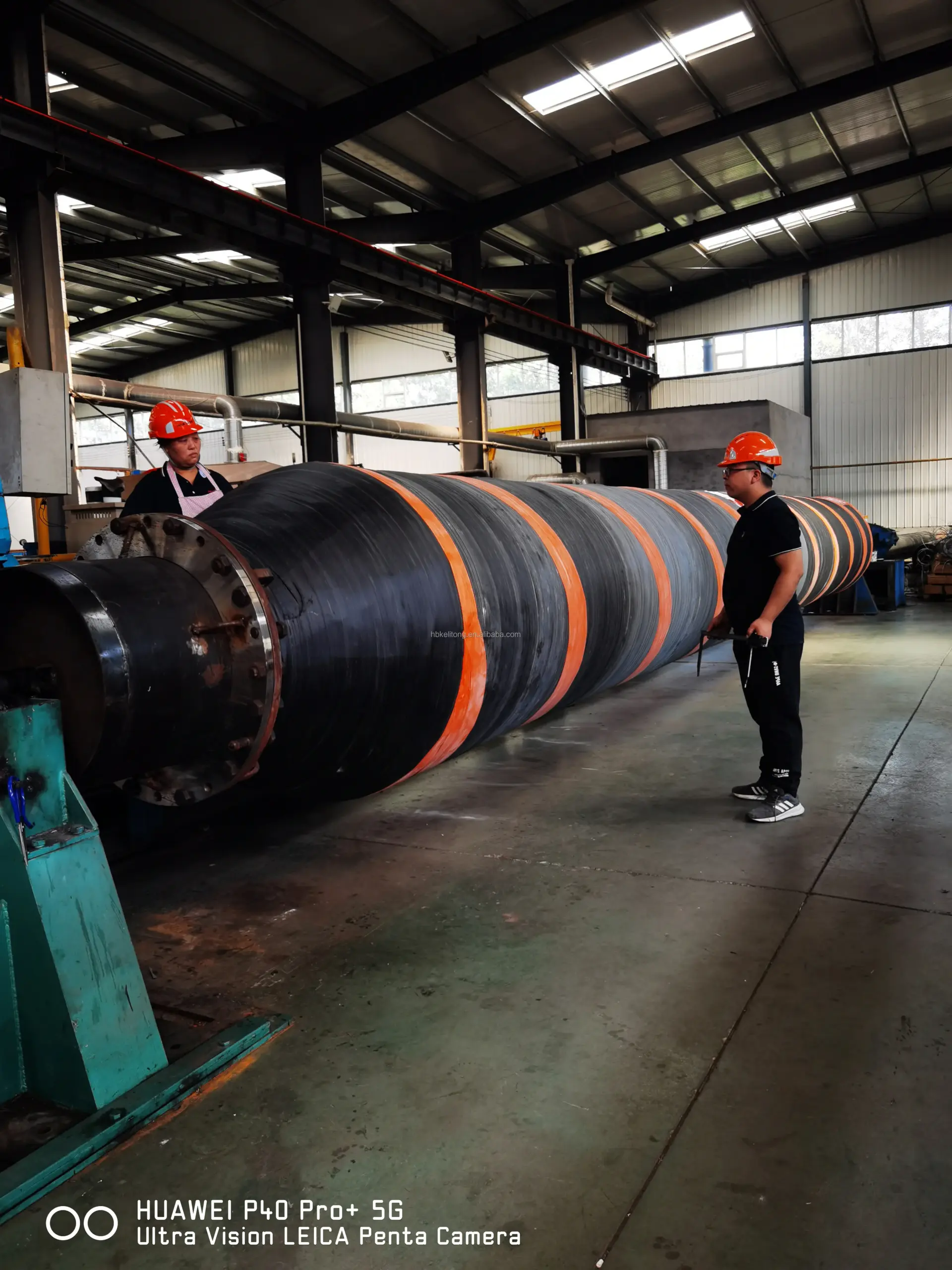
Imagen ilustrativa relacionada con Manguera de goma flotante
¿Cómo se comporta el caucho natural (NR) en las mangueras de caucho flotantes?
El caucho natural (NR) es famoso por su excelente elasticidad y resistencia. Suele ofrecer una buena resistencia a la tracción y flexibilidad, lo que lo hace adecuado para aplicaciones que requieren flexión y movimiento. El caucho natural soporta temperaturas de entre -20 °C y +70 °C, pero es menos resistente a aceites y productos químicos, lo que puede degradarlo con el tiempo.
Pros: Las principales ventajas del NR son su alta resistencia a la tracción y su gran flexibilidad, esenciales para las aplicaciones dinámicas. Además, suele ser más rentable que las alternativas sintéticas.
Contras: Sin embargo, el NR tiene una resistencia limitada al petróleo y a determinados productos químicos, lo que puede restringir su uso en aplicaciones con hidrocarburos. Su rendimiento también puede disminuir en condiciones climáticas extremas.
Impacto en la aplicación: El NR es ideal para operaciones de dragado en agua dulce, pero puede no ser adecuado para aplicaciones relacionadas con el petróleo debido a su susceptibilidad a la degradación química.
¿Qué ventajas ofrece el caucho nitrílico (NBR) para las mangueras flotantes?
El caucho nitrílico (NBR) es un caucho sintético conocido por su excelente resistencia al aceite, el combustible y otros productos químicos. Las mangueras de NBR suelen soportar temperaturas de -30 °C a +100 °C y ofrecen buenas propiedades mecánicas, por lo que son adecuadas para entornos marinos exigentes.
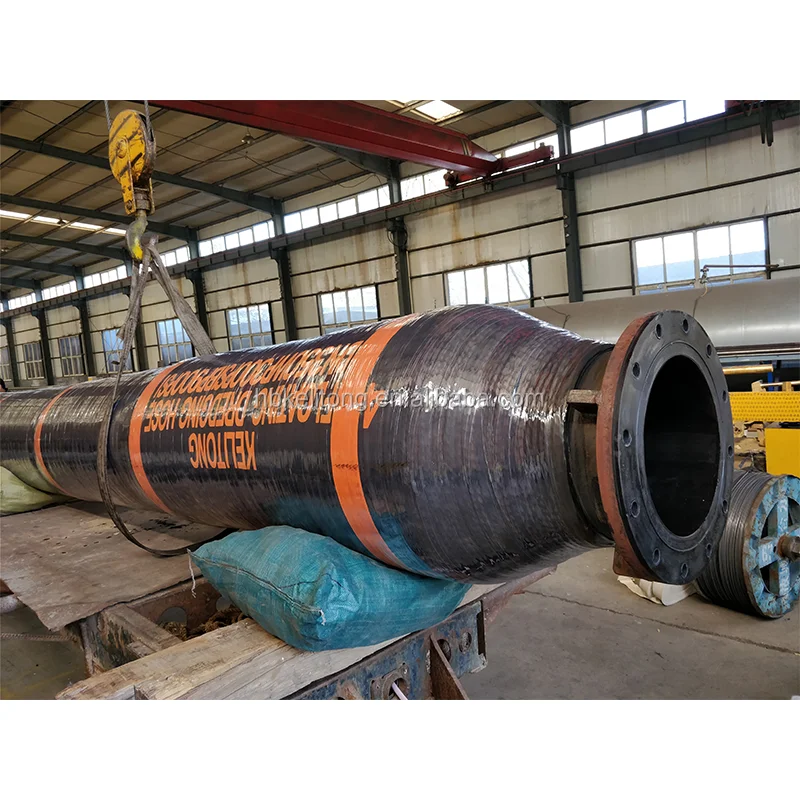
Imagen ilustrativa relacionada con Manguera de goma flotante
Pros: La principal ventaja del NBR es su resistencia química superior, que permite su uso en aplicaciones relacionadas con el trasiego de aceite y combustible. También mantiene su flexibilidad y resistencia a temperaturas variables.
Contras: En el lado negativo, el NBR puede ser más caro que el NR y puede tener una vida útil más corta cuando se expone a la luz UV y al ozono.
Impacto en la aplicación: El NBR es especialmente adecuado para operaciones de trasvase de petróleo en alta mar y dragado en entornos en los que predomina la exposición a hidrocarburos.
¿Cómo se compara el caucho estireno-butadieno (SBR) con las aplicaciones de mangueras flotantes?
El caucho estireno-butadieno (SBR) es otro caucho sintético que ofrece un equilibrio entre rendimiento y coste. Tiene una buena resistencia a la abrasión y puede funcionar eficazmente en un rango de temperaturas de -20 °C a +80 °C.
Pros: El SBR tiene un coste relativamente bajo y unas propiedades mecánicas aceptables, lo que lo convierte en una opción popular para las mangueras flotantes de uso general.
Contras: Sin embargo, carece de la resistencia al aceite del NBR y puede degradarse cuando se expone a condiciones ambientales duras, incluida la luz ultravioleta.
Impacto en la aplicación: El SBR es adecuado para aplicaciones de agua dulce y operaciones de dragado en las que la exposición al petróleo es mínima, por lo que constituye una solución rentable para muchos usuarios.
¿Qué papel desempeña el poliuretano (PU) en el diseño de mangueras de caucho flotantes?
El poliuretano (PU) es conocido por su extraordinaria resistencia a la abrasión y su flexibilidad. Soporta temperaturas de -30 °C a +80 °C y es muy resistente al desgaste, por lo que resulta ideal para entornos marinos difíciles.
Pros: La principal ventaja del PU es su durabilidad y resistencia a la abrasión, lo que prolonga considerablemente la vida útil de las mangueras flotantes. Su flexibilidad facilita la manipulación y la instalación.
Contras: Sin embargo, el PU puede ser más caro que otros materiales y no ofrecer el mismo nivel de resistencia química que el NBR.
Impacto en la aplicación: Las mangueras de PU son excelentes para aplicaciones de alta abrasión, como el dragado en fondos marinos rocosos o irregulares, donde la durabilidad es primordial.
Tabla resumen de selección de materiales para mangueras de goma flotantes
| Material | Caso típico de uso de la manguera de goma flotante | Ventajas clave | Principales desventajas/limitaciones | Coste relativo (Bajo/Medio/Alto) |
|---|---|---|---|---|
| Caucho natural (NR) | Operaciones de dragado en agua dulce | Gran elasticidad y flexibilidad | Resistencia limitada al aceite y a los productos químicos | Bajo |
| Caucho nitrílico (NBR) | Transferencia de petróleo en alta mar | Excelente resistencia química | Vida útil más corta bajo exposición UV | Alta |
| Caucho estireno-butadieno (SBR) | Mangueras flotantes de uso general | Rentabilidad y rendimiento decente | Poca resistencia al aceite | Medio |
| Poliuretano (PU) | Aplicaciones de dragado de alta abrasión | Excelente durabilidad y resistencia a la abrasión | Coste más elevado que otros | Alta |
Esta guía estratégica de selección de materiales ofrece a los compradores B2B información esencial sobre los materiales utilizados en las mangueras de caucho flotantes. Comprender las propiedades, ventajas y limitaciones de cada material puede ayudar a tomar decisiones de compra informadas y adaptadas a necesidades operativas y condiciones medioambientales específicas.
En profundidad: Procesos de fabricación y garantía de calidad de la manguera de caucho flotante
¿Cuáles son las etapas clave del proceso de fabricación de la manguera de caucho flotante?
La fabricación de mangueras de caucho flotantes implica varias etapas críticas, cada una de ellas diseñada para garantizar que el producto final satisface las rigurosas exigencias de las aplicaciones marinas y de dragado.
-
Preparación del material: La base de cualquier manguera de caucho flotante de alta calidad reside en las materias primas. Normalmente, el proceso de fabricación comienza con la selección de caucho natural (NR) de alta calidad, caucho sintético (como NBR o SBR) y materiales de refuerzo. Estos materiales se mezclan cuidadosamente con aditivos para mejorar propiedades como la resistencia a la abrasión, la estabilidad UV y la durabilidad general.
-
Formando: Una vez preparado el material, el siguiente paso consiste en formar la estructura de la manguera. Esto se hace mediante extrusión, en la que la mezcla de caucho se fuerza a través de una matriz para crear un tubo continuo. El grosor y el diámetro de la manguera pueden ajustarse en función de las necesidades. En el caso de las mangueras flotantes, durante esta fase se suele integrar en la estructura un material de flotación de espuma para garantizar la flotabilidad.
-
Montaje: Una vez moldeada, la manguera se somete a un proceso de montaje que puede incluir la adición de bridas, acoplamientos y otros accesorios. Estos componentes son cruciales para conectar la manguera al equipo de dragado o a otros sistemas marinos. Las técnicas de montaje pueden incluir la vulcanización, en la que el caucho se calienta para crear enlaces cruzados que aumentan su resistencia y elasticidad.
-
Acabado: La fase final de la fabricación incluye procesos de acabado como el tratamiento de superficies y controles de calidad. Esto incluye la aplicación de revestimientos protectores para mejorar la resistencia frente a factores ambientales como la exposición a los rayos UV y la corrosión del agua de mar. Además, las mangueras suelen someterse a pruebas de control de calidad para confirmar que cumplen las normas internacionales.
¿Qué prácticas de garantía de calidad son esenciales para las mangueras de caucho flotantes?
La garantía de calidad es un aspecto fundamental del proceso de fabricación de mangueras de caucho flotantes, ya que garantiza que los productos sean seguros, fiables y adecuados para su finalidad. A continuación se describen las principales prácticas implicadas:
-
Cumplimiento de las normas internacionales: Los fabricantes de renombre cumplen normas de calidad internacionales como la ISO 9001, que establece los criterios de un sistema de gestión de calidad eficaz. Además, a menudo se exigen certificaciones específicas del sector, como las normas CE (para los mercados europeos) y API (American Petroleum Institute), sobre todo para las mangueras utilizadas en el transporte de petróleo y gas.
-
Puntos de control de calidad: La garantía de calidad está integrada en todo el proceso de producción a través de varios puntos de control:
– Control de calidad entrante (IQC): Esta etapa inicial consiste en inspeccionar las materias primas y los componentes para garantizar que cumplen las normas especificadas antes de que entren en la línea de producción.
– Control de calidad durante el proceso (IPQC): Durante la fabricación, se realizan controles periódicos para supervisar parámetros como las dimensiones de la manguera, el peso y las propiedades del material.
– Control de calidad final (CCF): Tras el montaje, las mangueras terminadas se someten a rigurosas pruebas de rendimiento, incluidas pruebas de presión, evaluaciones de flexibilidad y evaluaciones de flotabilidad. -
Métodos de ensayo: Se emplean varios métodos de prueba para garantizar el rendimiento de las mangueras en condiciones operativas. Las pruebas más comunes son:
– Pruebas hidrostáticas: Para evaluar la capacidad de la manguera para soportar la presión interna.
– Pruebas de resistencia a la abrasión: Para evaluar la resistencia de la manguera al desgaste.
– Pruebas de resistencia a los rayos UV: Para determinar la capacidad de la manguera para resistir la degradación por exposición a la luz solar.
¿Cómo pueden los compradores B2B verificar el control de calidad de los proveedores?
Para los compradores B2B internacionales, sobre todo en regiones como África, Sudamérica, Oriente Medio y Europa, verificar los procesos de control de calidad de un proveedor es crucial. He aquí algunas estrategias prácticas:
-
Auditorías de proveedores: La realización de auditorías in situ de posibles proveedores puede proporcionar información sobre sus procesos de fabricación, sistemas de control de calidad y capacidades operativas generales. Este compromiso directo permite a los compradores evaluar de primera mano el cumplimiento de las normas y prácticas.
-
Revisión de los informes de calidad: Solicitar informes de calidad detallados puede ayudar a los compradores a comprender los procedimientos de ensayo y los resultados. Estos informes deben incluir datos sobre el cumplimiento de las normas internacionales, los resultados de los métodos de prueba y cualquier métrica histórica de rendimiento de la calidad.
-
Inspecciones de terceros: La contratación de inspectores externos independientes puede añadir otro nivel de verificación. Estos inspectores pueden evaluar las instalaciones, los procesos y los productos del fabricante, proporcionando evaluaciones imparciales de las prácticas de control de calidad.
¿Qué matices deben tener en cuenta los compradores internacionales en relación con el control de calidad?
Cuando se abastecen de mangueras de caucho flotante a escala internacional, los compradores deben ser conscientes de los matices específicos que pueden afectar a la garantía de calidad:
-
Normas regionales: Los requisitos de certificación y ensayo pueden variar de una región a otra. Por ejemplo, las mangueras destinadas a aguas europeas pueden requerir el marcado CE, mientras que las destinadas a Oriente Medio pueden tener que cumplir normas locales específicas.
-
Diferencias culturales y normativas: Comprender las actitudes culturales hacia la calidad y los entornos normativos puede ayudar a seleccionar proveedores de confianza. En algunas regiones, puede haber un mayor énfasis en el cumplimiento y la certificación, mientras que en otras puede primar el coste sobre la calidad.
-
Comunicación: Una comunicación clara sobre las expectativas de calidad es vital. Los compradores deben asegurarse de que los proveedores comprenden sus necesidades y normas específicas para evitar cualquier discrepancia en la calidad del producto.
Conclusión
Los procesos de fabricación y las prácticas de garantía de calidad de las mangueras de caucho flotantes son fundamentales para garantizar el rendimiento y la fiabilidad en entornos marinos exigentes. Al comprender las etapas clave de la producción y aplicar sólidas medidas de control de calidad, los compradores B2B pueden tomar decisiones informadas a la hora de seleccionar proveedores. Si se hace hincapié en las normas internacionales y se mantienen abiertas las líneas de comunicación, aumentarán aún más las probabilidades de éxito de las adquisiciones en los diversos mercados mundiales.
Guía práctica de aprovisionamiento: Lista de comprobación paso a paso para la "Manguera de caucho flotante".
Esta guía es una lista de comprobación exhaustiva para los compradores B2B que deseen abastecerse eficazmente de mangueras de caucho flotantes. Siguiendo estos pasos, puede asegurarse de que su proceso de adquisición sea eficiente, rentable y adaptado a sus necesidades específicas.
Primer paso: Defina sus especificaciones técnicas
Establecer unas especificaciones técnicas claras es esencial para garantizar que la manguera de goma flotante cumpla sus requisitos operativos. Tenga en cuenta factores como la aplicación prevista, el diámetro, la longitud y la presión nominal. Además, tenga en cuenta las condiciones ambientales, como los rangos de temperatura y la exposición a productos químicos o a la luz ultravioleta.
- Parámetros clave a especificar:
- Medidas del diámetro interior y exterior.
- Presión de trabajo e intervalo de temperatura requeridos.
- Materiales específicos necesarios para la durabilidad y el rendimiento.
Segundo paso: Realizar estudios de mercado
Comprender el panorama del mercado le ayudará a identificar posibles proveedores y a calibrar las tendencias de precios. Investiga a varios fabricantes y distribuidores de mangueras de goma flotantes, prestando atención a su reputación en el sector. Utilice plataformas en línea, ferias comerciales y publicaciones del sector para recabar información.
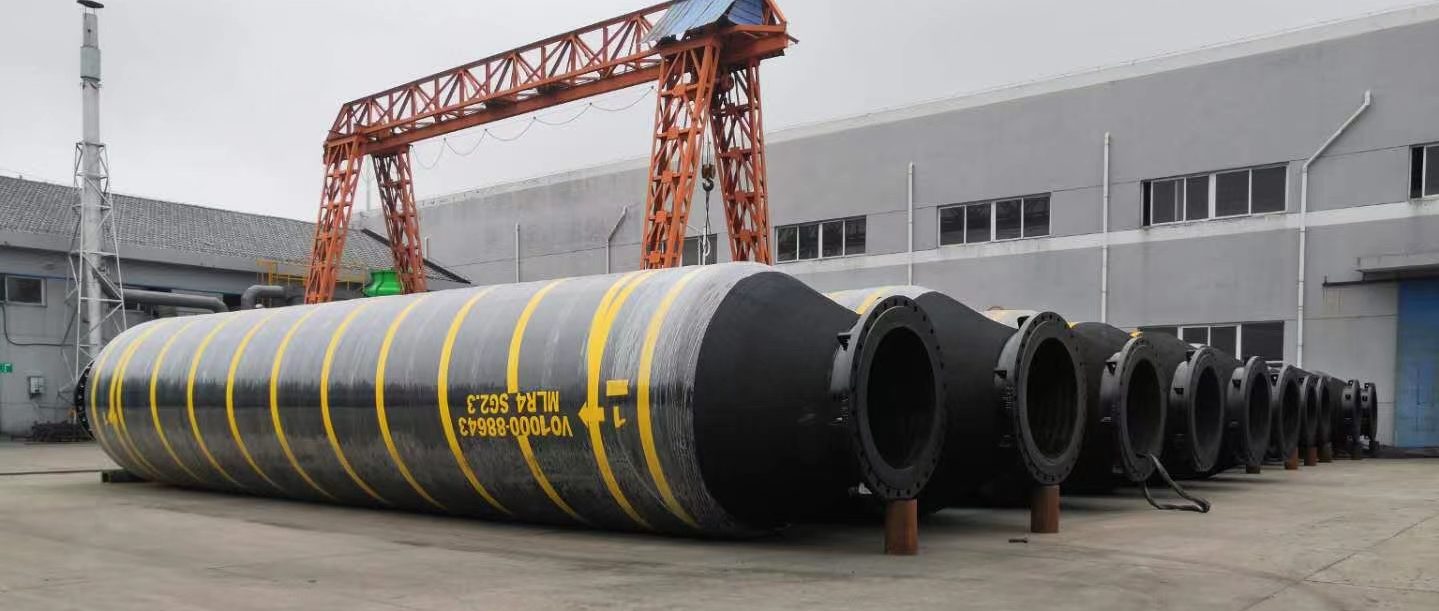
Imagen ilustrativa relacionada con Manguera de goma flotante
- Áreas de investigación por explorar:
- Opiniones y valoraciones de proveedores.
- Estudios de casos de proyectos anteriores.
- Proveedores regionales que pueden ofrecer plazos de entrega más rápidos.
Tercer paso: Evaluar posibles proveedores
Antes de comprometerse, es fundamental investigar a fondo a los proveedores. Solicite perfiles de empresa, estudios de casos y referencias de compradores de un sector o región similares. Evalúe su capacidad para cumplir sus especificaciones y plazos de entrega, así como su estabilidad financiera.
- Criterios de evaluación de proveedores:
- Certificaciones y cumplimiento de las normas industriales (ISO, ASTM).
- Capacidad de producción y plazos de entrega.
- Procesos de garantía de calidad y ofertas de garantía.
Paso 4: Solicitud de muestras para pruebas
La obtención de muestras es un paso vital en el proceso de aprovisionamiento. Probar las muestras le permite evaluar la calidad, flexibilidad y rendimiento de la manguera de caucho flotante en condiciones reales de trabajo. Este paso ayuda a mitigar el riesgo de adquirir productos de calidad inferior.
- Consideraciones sobre las pruebas:
- Realizar pruebas de presión y evaluaciones de resistencia a la abrasión.
- Evalúa la flotabilidad de la manguera y su rendimiento general en el agua.
- Revise los protocolos de ensayo del fabricante.
Paso 5: Negociar condiciones y precios
Entable conversaciones con los posibles proveedores para negociar precios, condiciones de pago y plazos de entrega. Comprender el coste total de propiedad, incluidos los gastos de envío y los posibles aranceles, le ayudará a tomar decisiones financieras con conocimiento de causa.
- Puntos centrales de la negociación:
- Descuentos por volumen para compras al por mayor.
- Condiciones de pago flexibles, como 30 neto o 60 neto.
- Gastos de envío y plazos de entrega.
Paso 6: Verificar las certificaciones de los proveedores
Asegurarse de que los proveedores poseen las certificaciones pertinentes es crucial para mantener la calidad y la conformidad. Busque certificaciones que demuestren su compromiso con la gestión de la calidad y la sostenibilidad medioambiental.
- Certificaciones clave que debe buscar:
- ISO 9001 (Gestión de la calidad).
- ISO 14001 (Gestión medioambiental).
- Certificaciones específicas del sector relacionadas con aplicaciones marinas o de dragado.
Paso 7: Establecer un canal de comunicación fiable
La comunicación eficaz con su proveedor es fundamental durante todo el proceso de adquisición y más allá. Establezca líneas de comunicación claras para obtener información actualizada sobre la producción, los envíos y cualquier posible problema que pueda surgir.
- Estrategias de comunicación:
- Designe un punto de contacto en ambas partes.
- Utiliza herramientas de gestión de proyectos para seguir el progreso.
- Programe revisiones periódicas para abordar cualquier preocupación.
Siguiendo esta lista de comprobación, los compradores B2B pueden agilizar su proceso de adquisición de mangueras de caucho flotantes, asegurándose de elegir los productos adecuados de proveedores fiables que satisfagan sus necesidades operativas.
Análisis exhaustivo de costes y precios de las mangueras de caucho flotantes Sourcing
¿Cuáles son los principales componentes del coste de producción de las mangueras de caucho flotantes?
Comprender la estructura de costes de las mangueras de caucho flotantes es crucial para los compradores B2B que deseen tomar decisiones de aprovisionamiento informadas. Los principales componentes del coste son:
-
Materiales: El caucho utilizado, normalmente una mezcla de compuestos naturales y sintéticos (NR/NBR/SBR), influye significativamente en el coste. Los materiales de alta calidad mejoran la durabilidad y el rendimiento, pero tienen un precio elevado. Además, el cuerpo flotante, a menudo de espuma de célula cerrada, aumenta el coste de los materiales.
-
Trabajo: Los costes de mano de obra varían según la región y los procesos de fabricación. La mano de obra cualificada es esencial para controlar la calidad y garantizar que las mangueras cumplen las rigurosas normas del sector. La automatización puede reducir los costes laborales, pero las inversiones iniciales en tecnología pueden ser considerables.
-
Gastos generales de fabricación: Incluye los costes relacionados con los servicios públicos, el mantenimiento y el funcionamiento de la fábrica. Los procesos de fabricación eficientes pueden mitigar estos costes, pero las ineficiencias pueden dar lugar a precios más altos.
-
Herramientas: El coste de los moldes y la maquinaria específica para la producción de mangueras es una inversión inicial significativa. Las solicitudes de personalización pueden conllevar un aumento de los costes de utillaje, ya que pueden ser necesarios moldes especializados.
-
Control de calidad: La aplicación de estrictas medidas de control de calidad garantiza que las mangueras cumplen las normas de seguridad y rendimiento, lo que puede aumentar los costes pero es vital para mantener la credibilidad del proveedor y reducir las devoluciones.
-
Logística: Los costes de transporte, incluidos los de envío y aduanas, son críticos, especialmente para los compradores internacionales. La proximidad a los proveedores puede reducir los costes logísticos, aunque también influyen factores como el precio del combustible y las tarifas locales.
-
Margen: Los proveedores incluirán un margen de beneficio en sus precios. Éste varía en función de las condiciones del mercado y de la competencia. Comprender las expectativas de margen de los proveedores puede ayudar en la negociación.
¿Qué influye en el precio de las mangueras de goma flotantes?
Varios factores influyen en el precio de las mangueras de caucho flotantes en el mercado B2B:
-
Volumen/MOQ: Los proveedores suelen ofrecer mejores precios por los pedidos al por mayor. Las cantidades mínimas de pedido (MOQ) pueden afectar significativamente a los precios; los pedidos más grandes suelen reducir los costes por unidad.
-
Especificaciones y personalización: Las especificaciones particulares, como diámetros o presiones nominales específicas, pueden incrementar los costes. Las solicitudes de personalización pueden implicar utillaje adicional y plazos de entrega más largos.
-
Calidad del material y certificaciones: Los materiales de mayor calidad y las certificaciones (por ejemplo, ISO, API) suelen tener precios más elevados, pero garantizan un mejor rendimiento y longevidad. Para los compradores internacionales, las certificaciones también pueden afectar a la normativa de importación.
-
Factores del proveedor: La reputación, fiabilidad y capacidad de producción del proveedor pueden influir en el precio. Los proveedores consolidados pueden ofrecer precios más altos debido a su historial demostrado y a su garantía de calidad.
-
Incoterms: Las condiciones de envío acordadas (por ejemplo, FOB, CIF) pueden influir significativamente en los costes totales. Los compradores deben conocer estas condiciones para evitar cargos inesperados en el momento de la entrega.
¿Qué consejos de negociación deben tener en cuenta los compradores?
Para optimizar los costes al adquirir mangueras de goma flotantes, los compradores deben tener en cuenta los siguientes consejos:
-
Investigar a fondo: Comprender los precios del mercado comparando diferentes proveedores y sus ofertas. Este conocimiento capacita a los compradores durante las negociaciones.
-
Aproveche los descuentos por volumen: Cuando sea posible, consolide los pedidos para cumplir las cantidades mínimas de producción y negocie precios al por mayor. Este enfoque puede suponer un importante ahorro de costes.
-
Evaluar el coste total de propiedad (TCO): Tenga en cuenta no sólo el precio de compra, sino también los costes de mantenimiento, sustitución y logística a lo largo de la vida útil del producto. Un coste inicial ligeramente superior puede suponer un menor TCO.
-
Establecer relaciones con los proveedores: El establecimiento de asociaciones a largo plazo puede dar lugar a mejores precios, acceso prioritario a los productos y un mejor servicio.
-
Prepárese para los matices de precios: Los compradores internacionales deben tener en cuenta las fluctuaciones monetarias, las condiciones del mercado local y las tasas reguladoras, que pueden afectar al precio final.
Conclusiones: Comprender los precios de las mangueras de caucho flotantes para compradores internacionales
Navegar por la estructura de costes y el panorama de precios de las mangueras de caucho flotantes puede ayudar a los compradores B2B internacionales, especialmente en regiones como África, Sudamérica, Oriente Medio y Europa. Teniendo en cuenta los componentes del coste, los factores que influyen en la fijación de precios y empleando tácticas de negociación estratégicas, los compradores pueden tomar decisiones informadas que se ajusten a sus necesidades operativas y limitaciones presupuestarias. Recuerde siempre que los precios pueden fluctuar en función de las condiciones del mercado, por lo que conviene mantenerse al corriente de las tendencias del sector y de las capacidades de los proveedores.
Análisis de alternativas: Comparación de la manguera de goma flotante con otras soluciones
Exploración de alternativas a la manguera de goma flotante: Un análisis comparativo
Cuando se trata de transportar líquidos en entornos marinos, las mangueras de caucho flotantes son ampliamente reconocidas por su eficacia y durabilidad. Sin embargo, existen soluciones alternativas que pueden adaptarse mejor a necesidades operativas específicas o a limitaciones presupuestarias. Este análisis ofrece una visión comparativa de las mangueras de caucho flotantes frente a dos alternativas viables: Tubo flotante de HDPE (polietileno de alta densidad) y Manguera flotante de material compuesto.
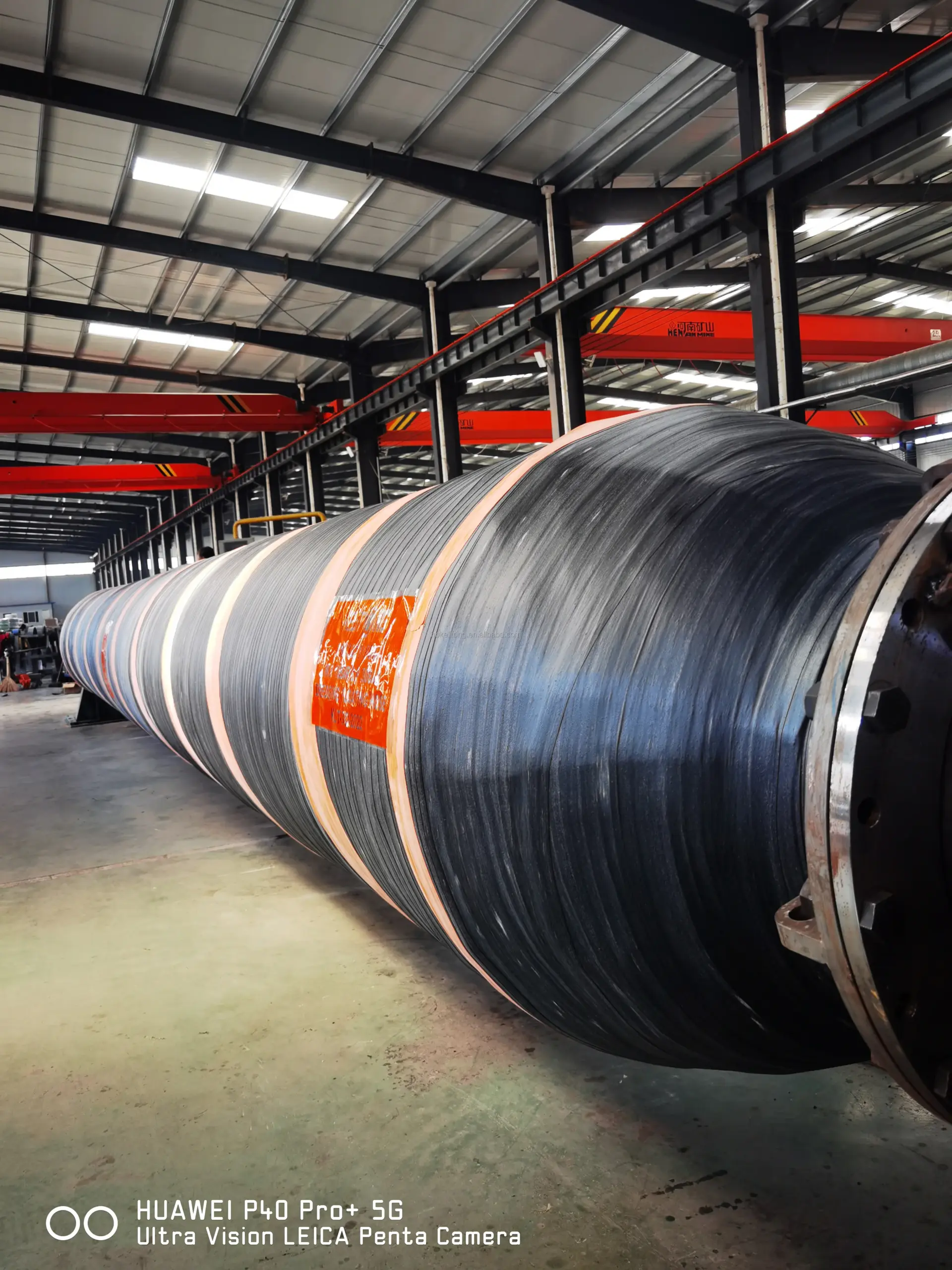
Imagen ilustrativa relacionada con Manguera de goma flotante
| Aspecto comparativo | Manguera de goma flotante | Tubo flotante HDPE | Manguera flotante de material compuesto |
|---|---|---|---|
| Rendimiento | Alta resistencia a la abrasión; adecuado para diversas condiciones de dragado | Buena flexibilidad; manejo moderado de la presión | Excelente resistencia química; peso ligero |
| Coste | Inversión inicial generalmente más elevada | Menor coste inicial; rentable para grandes proyectos | Más alto que el HDPE; el precio varía según las especificaciones |
| Facilidad de aplicación | Requiere accesorios especializados; complejidad de instalación moderada | Fácil de instalar con accesorios estándar | La complejidad de la instalación puede variar; requiere mano de obra cualificada |
| Mantenimiento | Revisiones periódicas de desgaste; mantenimiento moderado | Bajo mantenimiento; resistente a la corrosión | Requiere inspecciones periódicas; puede ser propenso a la degradación por UV |
| El mejor caso de uso | Ideal para proyectos de dragado y recuperación | Adecuado para el trasvase de agua a granel y el riego | Lo mejor para transportar productos químicos e hidrocarburos |
Alternativas en profundidad
Tubo flotante HDPE
Los tubos flotantes de HDPE se utilizan a menudo en sistemas de abastecimiento de agua, riego e incluso en aplicaciones de dragado debido a su flexibilidad y rentabilidad. Son ligeras, lo que facilita su transporte e instalación. Sin embargo, aunque las tuberías de HDPE son resistentes a muchos productos químicos, puede que no soporten las altas temperaturas o los materiales abrasivos con la misma eficacia que las mangueras de goma. Los compradores B2B pueden encontrar en el HDPE una opción atractiva para proyectos con limitaciones presupuestarias y menores exigencias de rendimiento.
Manguera flotante de material compuesto
Las mangueras flotantes de material compuesto están diseñadas para aplicaciones específicas, como el transporte de productos químicos e hidrocarburos. Ofrecen una excelente resistencia a una amplia gama de productos químicos y tienen una estructura ligera, lo que puede simplificar su manipulación e instalación. Sin embargo, su coste puede ser más elevado que el de las mangueras flotantes de caucho y las tuberías de HDPE, y su susceptibilidad a la degradación por rayos UV requiere una cuidadosa consideración en aplicaciones exteriores. Los compradores deben evaluar la compatibilidad química específica y las condiciones ambientales al considerar las mangueras compuestas.
Elección adecuada a sus necesidades
La elección de la solución adecuada entre mangueras flotantes de goma, tubos flotantes de HDPE y mangueras flotantes compuestas depende de diversos factores, como la aplicación específica, el presupuesto y el entorno operativo. Las mangueras flotantes de goma son ideales para tareas de dragado exigentes y entornos en los que la durabilidad es crucial. Por el contrario, las mangueras de HDPE pueden servir bien para aplicaciones menos exigentes en las que se prioriza la rentabilidad. Mientras tanto, las mangueras de materiales compuestos son las más adecuadas para tareas especializadas en las que intervienen materiales peligrosos.
Los compradores B2B deben realizar una evaluación exhaustiva de los requisitos de su proyecto, incluidos los tipos de materiales que deben transportarse, las condiciones de instalación y las capacidades de mantenimiento a largo plazo. Alineando las características de cada solución con las demandas operativas, las empresas pueden tomar decisiones informadas que mejoren la eficiencia y reduzcan los costes a largo plazo.
Propiedades técnicas esenciales y terminología comercial de la manguera de caucho flotante
¿Cuáles son las principales propiedades técnicas de la manguera de caucho flotante?
Las mangueras de goma flotantes son componentes críticos en diversas aplicaciones marinas y de dragado. Comprender sus propiedades técnicas es esencial para que los compradores B2B tomen decisiones de compra con conocimiento de causa. Estas son algunas de las especificaciones más importantes:
-
Composición del material
- Las mangueras flotantes de caucho suelen estar fabricadas con una mezcla de caucho natural (NR), caucho sintético (NBR o SBR) y reforzadas con hilos de multipoliéster. Esta combinación proporciona una excelente resistencia a la abrasión, flexibilidad y durabilidad frente a los duros entornos marinos.
– Importancia del B2B: La elección de los materiales influye directamente en la longevidad y el rendimiento de la manguera, por lo que es crucial que los compradores evalúen si los materiales satisfacen sus necesidades operativas. -
Diámetro interior (DI) y diámetro exterior (DE)
- Las mangueras flotantes vienen en varios tamaños, con diámetros interiores que oscilan entre 250 mm y 1.200 mm. El diámetro exterior viene determinado por el grosor de la pared de la manguera.
– Importancia del B2B: El tamaño afecta al caudal y al tipo de líquidos o materiales que pueden transportarse. Elegir las dimensiones correctas garantiza la eficiencia y reduce los costes operativos. -
Presión de trabajo (WP)
- La presión de trabajo de las mangueras flotantes suele oscilar entre 10 y 25 bares, en función del diseño y la aplicación. Esta especificación indica la presión máxima que la manguera puede soportar con seguridad durante su funcionamiento.
– Importancia del B2B: Conocer la presión de trabajo es vital para la seguridad y el rendimiento. Elegir una manguera con una presión nominal inadecuada puede provocar averías y costosos tiempos de inactividad. -
Temperatura
- Las mangueras de goma flotantes están diseñadas para funcionar en una gama de temperaturas de -30°C a +80°C. Esta versatilidad permite utilizarlas en distintos climas y condiciones.
– Importancia del B2B: Los compradores deben tener en cuenta su entorno operativo. Asegurarse de que las mangueras soportan las fluctuaciones de temperatura previstas evitará el desgaste prematuro y los fallos. -
Características de flotación y estabilidad
- Muchas mangueras flotantes incluyen espuma de célula cerrada para la flotabilidad, lo que evita la absorción de agua y garantiza la estabilidad durante su uso. El diseño suele incorporar un centro de gravedad bajo para mejorar la capacidad antioleaje.
– Importancia del B2B: La estabilidad y la flotabilidad son cruciales para las aplicaciones que implican el dragado o la transferencia en alta mar, lo que repercute en la eficacia y la seguridad de las operaciones.
¿Qué términos comerciales comunes deben entender los compradores B2B?
Navegar por la adquisición de mangueras de goma flotantes implica familiarizarse con la jerga del sector y los términos comerciales. He aquí algunos términos clave que resultan beneficiosos para los compradores B2B:
-
OEM (fabricante de equipos originales)
- Un OEM se refiere a una empresa que produce piezas o equipos que pueden ser comercializados por otro fabricante. En el contexto de las mangueras, designa al proveedor que fabrica las mangueras de caucho.
– Relevancia: Los compradores suelen preferir a los fabricantes de equipos originales por su calidad y fiabilidad garantizadas. -
MOQ (Cantidad mínima de pedido)
- MOQ es la cantidad más pequeña de un producto que un proveedor está dispuesto a vender. Este término es vital para negociar precios y determinar la viabilidad de los pedidos.
– Relevancia: Conocer las MOQ ayuda a los compradores a calibrar si un proveedor se ajusta a sus necesidades de aprovisionamiento, especialmente en el caso de compras al por mayor. -
RFQ (solicitud de presupuesto)
- Una petición de oferta es un proceso empresarial estándar en el que un comprador solicita información sobre precios a los proveedores para productos o servicios específicos.
– Relevancia: Emitir una petición de oferta permite a los compradores comparar ofertas y negociar mejores condiciones, asegurándose de obtener el mejor valor. -
Incoterms (Términos comerciales internacionales)
- Los Incoterms son un conjunto de términos comerciales predefinidos publicados por la Cámara de Comercio Internacional. Definen las responsabilidades de compradores y vendedores en materia de envío y entrega.
– Relevancia: Familiarizarse con los Incoterms ayuda a los compradores a comprender los costes de envío, la gestión de riesgos y las responsabilidades de entrega. -
Plazos de entrega
- El plazo de entrega se refiere al tiempo que transcurre desde que se realiza un pedido hasta la entrega del producto. Incluye el tiempo de fabricación, procesamiento y envío.
– Relevancia: Conocer el plazo de entrega es crucial para la planificación de proyectos y la gestión de inventarios, sobre todo en sectores con calendarios ajustados. -
Normas de certificación
- Las normas de certificación (por ejemplo, ISO, API) indican que los productos cumplen criterios específicos de calidad y seguridad. Las certificaciones suelen ser esenciales para el cumplimiento de la normativa en muchas industrias.
– Relevancia: Los compradores deben verificar las certificaciones para asegurarse de que las mangueras cumplen los requisitos reglamentarios y las normas del sector, lo que mejora la seguridad y el rendimiento.
Al conocer estas propiedades técnicas y condiciones comerciales, los compradores B2B pueden tomar decisiones informadas a la hora de adquirir mangueras de caucho flotantes, lo que en última instancia conduce a resultados satisfactorios en los proyectos y a la eficiencia operativa.
Dinámica del mercado y tendencias de abastecimiento en el sector de las mangueras de caucho flotantes
¿Cuáles son la dinámica actual del mercado y las principales tendencias que influyen en el sector de las mangueras de caucho flotantes?
El mercado de mangueras de goma flotantes está experimentando un aumento de la demanda impulsado por la creciente necesidad mundial de dragados eficientes, transporte de petróleo y gas, y actividades de construcción marina. Entre los principales impulsores figuran el aumento de las inversiones en infraestructuras en las economías emergentes, sobre todo en África y Sudamérica, así como la expansión de la prospección de petróleo y gas en alta mar en Oriente Próximo y Europa. El mercado también se ve influido por los avances tecnológicos, como el desarrollo de materiales de alto rendimiento que mejoran la durabilidad y el rendimiento en condiciones extremas.
Los compradores internacionales B2B buscan cada vez más proveedores que ofrezcan soluciones personalizadas adaptadas a las necesidades específicas de cada proyecto, como diámetros y presiones nominales variables. Esto es particularmente relevante en regiones como Brasil y Nigeria, donde las condiciones ambientales únicas requieren mangueras flotantes especializadas. Además, la transformación digital está reconfigurando los procesos de abastecimiento, con plataformas que facilitan las comprobaciones de inventario en tiempo real, las comparaciones de precios y las evaluaciones de proveedores, lo que facilita a los compradores la toma de decisiones informadas.
Las tendencias emergentes también incluyen el aumento de las mangueras flotantes multifuncionales que pueden utilizarse para diversas aplicaciones, desde el dragado hasta la transferencia de fluidos en entornos peligrosos. Los compradores deben estar atentos a estas innovaciones, ya que representan oportunidades para racionalizar las operaciones y reducir los costes.
¿Cómo influyen la sostenibilidad y el abastecimiento ético en el mercado de las mangueras de caucho flotantes?
La sostenibilidad se está convirtiendo en una consideración crítica en el sector de las mangueras de caucho flotantes, impulsada por las crecientes presiones normativas y la demanda de productos respetuosos con el medio ambiente por parte de los consumidores. El impacto medioambiental de la producción y eliminación del caucho es significativo, lo que impulsa a los fabricantes a explorar materiales y procesos de producción sostenibles. Se anima a los compradores B2B a buscar proveedores que utilicen certificaciones "verdes" y materiales ecológicos, ya que estas prácticas no sólo minimizan la huella medioambiental, sino que también mejoran la reputación de las empresas.
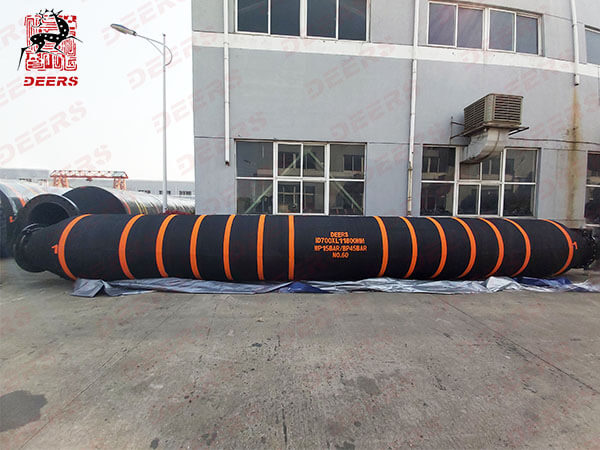
Imagen ilustrativa relacionada con Manguera de goma flotante
El aprovisionamiento ético ha ganado terreno en los últimos años, con un énfasis en la transparencia a lo largo de la cadena de suministro. Los compradores deben dar prioridad a las asociaciones con fabricantes que se adhieran a prácticas laborales éticas y demuestren su compromiso con la responsabilidad social. Al alinearse con los proveedores que se centran en la sostenibilidad y el abastecimiento ético, los compradores B2B pueden contribuir a una industria más responsable, garantizando al mismo tiempo el cumplimiento de las normas y reglamentos internacionales.
¿Cuál es el contexto histórico del desarrollo de las mangueras de caucho flotantes relevante para los compradores B2B de hoy en día?
La evolución de las mangueras de goma flotantes se remonta a mediados del siglo XX, cuando se utilizaban principalmente en operaciones de dragado. Con el paso de las décadas, los avances en la ciencia de los materiales han dado lugar a mejoras significativas en el diseño de las mangueras, incluida una mayor resistencia a la abrasión, protección UV y longevidad. Estas innovaciones han ampliado las aplicaciones de las mangueras flotantes más allá del dragado para incluir funciones críticas en el transporte de petróleo y gas y en proyectos de infraestructuras marinas.
En la actualidad, el énfasis en el rendimiento y la fiabilidad refleja la respuesta de la industria a las crecientes demandas de los compradores B2B de productos que puedan resistir los duros entornos marinos y, al mismo tiempo, mantener la eficiencia operativa. Comprender este contexto histórico puede ayudar a los compradores a apreciar los avances tecnológicos que han dado forma al mercado actual y a tomar decisiones informadas a la hora de adquirir mangueras de caucho flotantes. Dado que el sector sigue innovando, mantenerse al día de estos avances será esencial para el éxito de las estrategias de aprovisionamiento.
Preguntas frecuentes para compradores B2B de manguera de caucho flotante
-
¿Cómo elijo la manguera de goma flotante adecuada para mi proyecto?
La selección de la manguera de goma flotante adecuada implica tener en cuenta varios factores, como la aplicación, la presión de trabajo y las condiciones ambientales. Evalúe el tipo de materiales que va a transportar: las opciones más comunes incluyen lodo, arena o aceite. Además, evalúe el diámetro y la longitud necesarios en función de sus necesidades operativas específicas. Busque mangueras con características como resistencia a los rayos UV y protección contra la abrasión, especialmente para entornos marinos difíciles. Consultar a los proveedores puede ayudarle a determinar las mejores especificaciones de manguera para su proyecto. -
¿Cuál es el mejor material para las mangueras de goma flotantes?
Los mejores materiales para las mangueras de caucho flotante suelen ser el caucho natural (NR), el caucho nitrílico (NBR) y las mezclas de caucho sintético. Estos materiales ofrecen una excelente resistencia a la abrasión, flexibilidad y durabilidad. Al seleccionar una manguera, tenga en cuenta los requisitos específicos de su aplicación, como los rangos de temperatura y la compatibilidad química. Además, los diseños reforzados con múltiples capas de poliéster proporcionan una mayor resistencia y estabilidad, lo que los hace adecuados para las exigentes condiciones marinas. -
¿Cuáles son las cantidades mínimas de pedido (CMP) habituales para las mangueras de caucho flotantes?
Las cantidades mínimas de pedido de mangueras de caucho flotantes pueden variar significativamente en función del proveedor y de la línea de productos específica. Normalmente, las cantidades mínimas de pedido oscilan entre 10 y 50 mangueras, en función de la personalización y las especificaciones requeridas. Es esencial preguntar directamente a los posibles proveedores para conocer sus cantidades mínimas de pedido, así como las reducciones de precio para pedidos más grandes, lo que puede ser especialmente beneficioso para los compradores B2B que deseen abastecerse para proyectos en curso. -
¿Cómo puedo verificar la fiabilidad de un proveedor de mangueras de caucho flotantes?
Para asegurarse de la fiabilidad de un proveedor, realice una investigación exhaustiva que incluya la comprobación de las opiniones de los clientes, las certificaciones del sector y su historial en el cumplimiento de pedidos internacionales. Solicite referencias de clientes anteriores y evalúe su capacidad de respuesta y su servicio de atención al cliente durante las comunicaciones iniciales. Además, tenga en cuenta a los proveedores que proporcionan muestras de productos o especificaciones detalladas y certificaciones de pruebas, que pueden indicar un compromiso con la calidad y la fiabilidad. -
¿Qué opciones de personalización existen para las mangueras de caucho flotantes?
Las opciones de personalización de las mangueras de caucho flotante suelen incluir variaciones de diámetro, longitud, presión de trabajo e incluso composiciones específicas de materiales para adaptarse a aplicaciones únicas. Muchos proveedores pueden personalizar las mangueras con bridas específicas, colores o características de protección adicionales en función de sus requisitos. Cuando hable de personalización, comunique claramente al proveedor las necesidades de su proyecto para asegurarse de que puede cumplir sus especificaciones con eficacia. -
¿Qué condiciones de pago debo esperar cuando compro mangueras de caucho flotantes a nivel internacional?
Las condiciones de pago de los pedidos internacionales de mangueras de caucho flotantes pueden variar, pero suelen incluir opciones como el pago por adelantado, cartas de crédito o el pago a la entrega. Muchos proveedores pueden exigir un depósito por adelantado y el resto a la entrega. Es fundamental aclarar las condiciones de pago antes de finalizar el pedido y asegurarse de que se ajustan a su presupuesto y a sus necesidades de tesorería. Busque proveedores que ofrezcan métodos de pago seguros para mitigar los riesgos. -
¿Qué medidas de garantía de calidad debo buscar en las mangueras de caucho flotante?
Cuando compre mangueras de goma flotantes, infórmese sobre los procesos de garantía de calidad del proveedor. Busque certificaciones como la ISO 9001, que indica el cumplimiento de las normas internacionales de gestión de calidad. Además, pregunte por los procedimientos de prueba de las mangueras, incluidas las pruebas de presión y las inspecciones de materiales. Los proveedores fiables deben proporcionar documentación sobre sus medidas de control de calidad, garantizando que las mangueras cumplen las normas del sector y son adecuadas para sus aplicaciones específicas. -
¿Qué consideraciones logísticas debo tener en cuenta al importar mangueras de caucho flotantes?
La logística es un aspecto crítico de la importación de mangueras de caucho flotantes. Tenga en cuenta factores como los métodos de envío, los plazos de entrega y la normativa aduanera de su país. Póngase en contacto con proveedores que tengan experiencia en envíos internacionales y puedan ayudarle con la documentación necesaria para el despacho de aduanas. Además, evalúe los gastos de envío y los posibles aranceles de importación para asegurarse de que se ajustan a su presupuesto. Establezca una comunicación clara con su proveedor en relación con la logística para evitar retrasos y garantizar una entrega puntual.
Lista de los 7 mejores fabricantes y proveedores de manguera de goma flotante
1. Trelleborg - Mangueras flotantes de dragado
Dominio: trelleborg.com
Inscrito: 1996 (29 años)
Introducción: Las mangueras flotantes de dragado de Trelleborg están diseñadas para su uso en grandes proyectos de recuperación en todo el mundo. Han sido rediseñadas para satisfacer la creciente demanda de mayor vida útil y se utilizan cada vez más en trabajos de corte. Las mangueras están revestidas de caucho y forman parte de la amplia experiencia de Trelleborg en soluciones de polímeros de ingeniería para infraestructuras marinas y civiles.
2. Dredge Brokers - Manguera de dragado flotante de goma 16
Dominio: dredgebrokers.com
Matriculado: 2005 (20 años)
Introducción: [{'type': 'Manguera de dragado flotante de caucho de 16"', 'price': '2,500 USD', 'location': 'Alabama', 'details': 'Manguera de dragado flotante de caucho de 16" en venta. 14 Secciones disponibles. Compra incluirá bastidores. Incluye todas las tuercas y tornillos. Longitudes de 35′ y 39′. Manguera más vieja que nunca se ha utilizado y ha estado en bastidores y cubierto.'}, {'type': '24" Rubber Dredge Hose', 'price': '2,500 USD', 'location': 'Alabama', ...
3. CDSR - Soluciones de mangueras flotantes
Dominio: cdsr-tech.com
Inscrito: 2022 (3 años)
Introducción: Mejor manguera flotante (manguera de descarga flotante / manguera de dragado) Fabricante y proveedor | CDSR. Las Mangueras Flotantes se instalan en la línea principal de soporte de la draga y se utilizan para tuberías flotantes. Adecuadas para temperaturas ambiente que oscilan entre -20℃ y 50℃, transportan mezclas de agua (o agua de mar), limo, barro, arcilla y arena. Compuesto de revestimiento, capas de refuerzo, camisa de flotación, c...
4. JYM - Manguera flotante de dragado
Dominio: jymfg.com
Registrado: 2018 (7 años)
Introducción: Manguera de dragado flotante Características: 1. Cubierta exterior fabricada con un compuesto de caucho resistente a la intemperie, a los rayos UV y al Ozono. 2. Capas indicadoras de desgaste para el transporte de medios abrasivos. 3. 3. Una sola capa flotante de espuma evita la absorción de agua; la emergencia de la manguera sobre el agua no es inferior a 20% del volumen total. 4. Bridas personalizadas disponibles. 5. Ángulo de flexión: de 0° a +45° en condiciones de trabajo. 6. Construcción: Interior...
5. Continental - Manguera flotante estándar
Dominio: continental-industry.com
Registrado: 2018 (7 años)
Introducción: La manguera flotante estándar forma parte de la categoría de mangueras de manipulación de materiales, dragado y minería de Mangueras industriales de Continental Industry. Está diseñada para el almacenamiento y transporte de líquidos en aplicaciones de dragado y minería de fondos marinos.
6. JSDY Marine - Mangueras de dragado flotantes
Dominio: jsdymarine.com
Inscrito: 2022 (3 años)
Introducción: Las mangueras de dragado flotantes se utilizan con dragas para el transporte de limo/grava, adecuadas para lodo, arcilla, arena fina y arena fina-media. La temperatura de trabajo oscila entre -20℃ y +50℃. Las dimensiones incluyen un diámetro interior (DI) de 100 a 1100 mm y una longitud de 1000 a 11800 mm. La construcción presenta una capa interior de caucho de mezcla negro resistente al desgaste y a la corrosión, refuerzo textil de alta resistencia a la tracción ...
7. Nanjing Deers - Mangueras flotantes de dragado
Dominio: chinarubberfender.com
Inscrito: 2011 (14 años)
Introducción: Productos: Mangueras flotantes de dragado
Fabricante: Nanjing Deers Industrial Co., Ltd
Aplicaciones: Utilizado con dragas para el transporte de limo/grava; adecuado para barro, arcilla, arena fina, arena fina-media.
Temperatura de trabajo: -20℃ a +50℃
Características del producto:
1. Cubierta exterior con excelente resistencia a la abrasión y protección UV.
2. Capa indicadora de color.
3. Carcasa de flotación de espuma simple para evitar la absorción de agua...
Conclusión estratégica y perspectivas de la manguera de caucho flotante
En conclusión, el aprovisionamiento estratégico eficaz de mangueras de caucho flotantes es fundamental para las empresas que participan en proyectos marítimos y de infraestructuras. Al dar prioridad a la calidad, la durabilidad y la fiabilidad del proveedor, las empresas pueden garantizar un rendimiento óptimo en entornos exigentes. La información recabada de los principales fabricantes pone de relieve la necesidad de adquirir mangueras que cumplan requisitos operativos específicos, como la presión nominal y la resistencia medioambiental.
Además, la comprensión de la dinámica del mercado regional -especialmente en África, Sudamérica, Oriente Medio y Europa- permite a los compradores tomar decisiones de compra informadas que se ajusten a sus necesidades operativas y a sus limitaciones presupuestarias. La disponibilidad de mangueras, tanto nuevas como excedentarias, ofrece la oportunidad de realizar compras rentables, sobre todo en regiones que experimentan un rápido crecimiento industrial.
A medida que aumenta la demanda de soluciones sostenibles y de alto rendimiento, los compradores internacionales deben buscar activamente asociaciones con proveedores reputados que puedan ofrecer soluciones a medida. Si adoptan prácticas de abastecimiento estratégicas, las empresas pueden mejorar su eficiencia operativa y su ventaja competitiva en el mercado mundial. Ahora es el momento de explorar estas oportunidades e invertir en mangueras de caucho flotantes de alta calidad que respaldarán sus proyectos durante años.
Descargo de responsabilidad y condiciones de uso
⚠️ Descargo de responsabilidad importante
La información facilitada en esta guía, incluido el contenido relativo a fabricantes, especificaciones técnicas y análisis de mercado, tiene únicamente fines informativos y educativos. No constituye asesoramiento profesional en materia de adquisiciones, asesoramiento financiero ni asesoramiento jurídico.
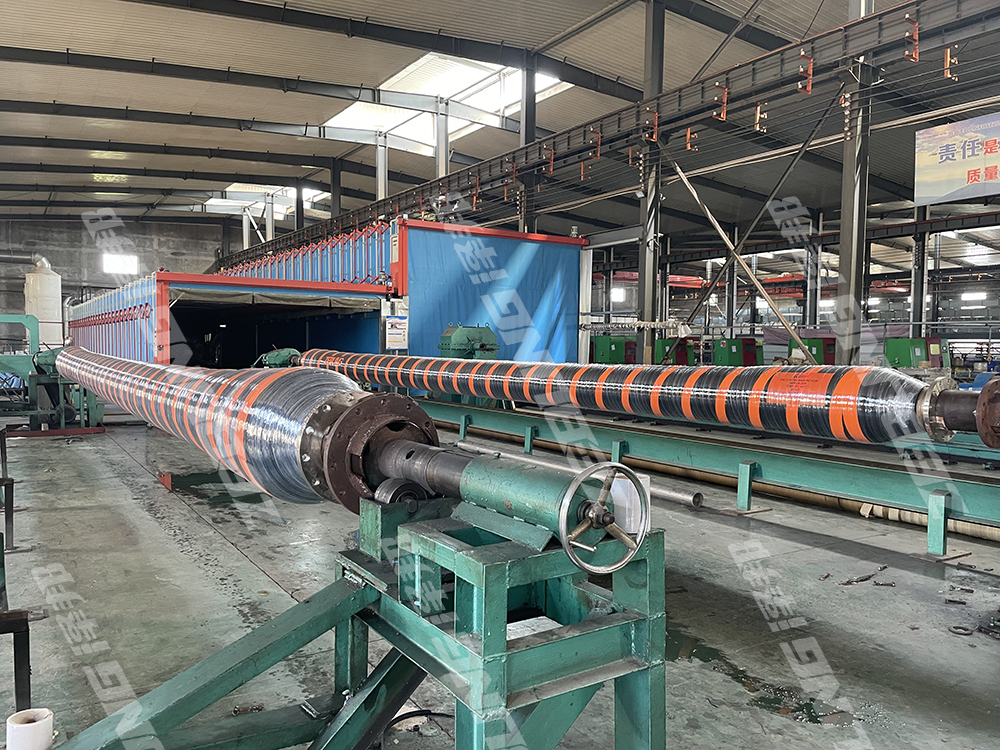
Imagen ilustrativa relacionada con Manguera de goma flotante
Aunque hemos hecho todo lo posible por garantizar la exactitud y actualidad de la información, no nos hacemos responsables de posibles errores, omisiones o información obsoleta. Las condiciones del mercado, los detalles de las empresas y las normas técnicas están sujetos a cambios.
Los compradores B2B deben llevar a cabo su propia diligencia debida independiente y exhaustiva antes de tomar cualquier decisión de compra. Esto incluye ponerse en contacto directamente con los proveedores, verificar las certificaciones, solicitar muestras y buscar asesoramiento profesional. El riesgo de confiar en la información contenida en esta guía es responsabilidad exclusiva del lector.

